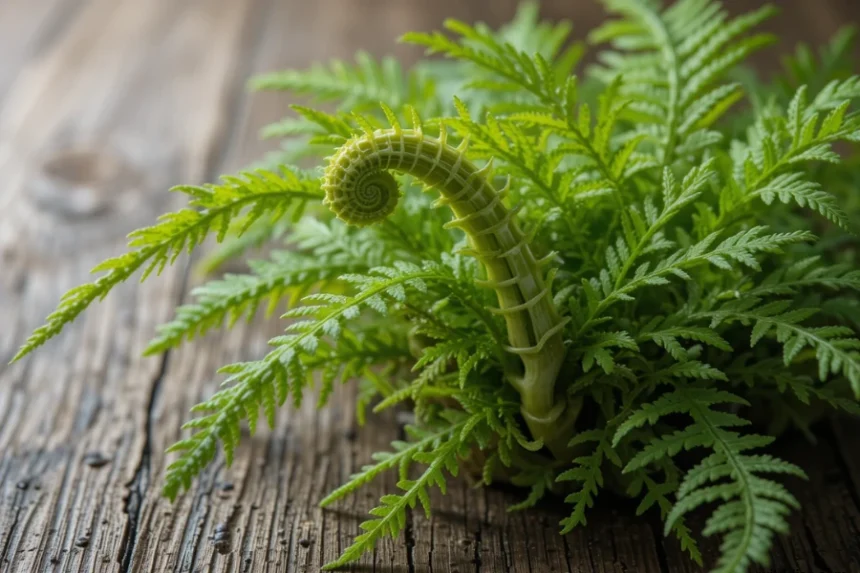Fiddlehead ferns, the young, unfurled fronds of certain fern species, have gained popularity as a nutritious and delicious addition to various cuisines. Beyond their culinary appeal, fiddlehead ferns offer numerous health benefits that make them a valuable inclusion in your diet. In this article, we will explore the remarkable fiddlehead ferns health benefits, their nutritional profile, and how to enjoy them safely.
What Are Fiddlehead Ferns?
Fiddlehead ferns are the tightly coiled fronds of ferns like ostrich fern, bracken, and others. When they are young and just beginning to sprout, they resemble the curled heads of fiddle-playing strings—hence the name. These ferns are harvested in the early spring and are widely enjoyed in North American, Asian, and European cuisines.
They are typically harvested along rivers, streams, and wooded areas, and are appreciated for their tender texture and unique flavor. Their taste is often described as a mix between asparagus, spinach, and green beans, making them a versatile ingredient in many dishes.
Fiddlehead Ferns Health Benefits
1. Rich Source of Antioxidants
Fiddlehead ferns are packed with antioxidants such as vitamin C and other phytochemicals, which help neutralize harmful free radicals. Regular consumption can reduce oxidative stress, lowering the risk of chronic diseases like heart disease, diabetes, and certain cancers.
2. Boosts Immune System
Thanks to their high vitamin C content, fiddlehead ferns can strengthen the immune system. Vitamin C is essential for immune cell function and enhances the body’s ability to fend off infections and illnesses.
3. Supports Digestive Health
The dietary fiber found in fiddlehead ferns promotes healthy digestion by adding bulk to stool and supporting regular bowel movements. It also fosters beneficial gut bacteria, which is vital for nutrient absorption and immune health.
4. Promotes Eye Health
Fiddlehead ferns contain significant amounts of vitamin A, which is crucial for maintaining healthy vision. Consuming foods rich in vitamin A can reduce the risk of age-related macular degeneration and other eye conditions.
5. Enhances Heart Health
The potassium content in fiddlehead ferns helps regulate blood pressure levels, preventing hypertension. Additionally, their antioxidant properties protect blood vessels from damage, decreasing the risk of cardiovascular diseases.
6. Provides Essential Minerals for Bone Strength
Minerals like magnesium, manganese, and iron present in fiddlehead ferns contribute to bone density and overall skeletal health. These nutrients are vital for preventing osteoporosis and maintaining mobility as we age.
7. Anti-Inflammatory Benefits
Compounds in fiddlehead ferns exhibit anti-inflammatory properties, which can help reduce inflammation associated with chronic conditions such as arthritis. Regular inclusion in the diet may provide relief from inflammatory discomfort.
Nutritional Profile of Fiddlehead Ferns
Fiddlehead ferns are not only delicious but also nutritional powerhouses. They are low in calories but rich in essential nutrients, including:
Vitamins: Rich in vitamin A, vitamin C, and some B-vitamins such as riboflavin and niacin.
Minerals: High in minerals like potassium, magnesium, iron, and manganese.
Antioxidants: Contain various antioxidants that help combat oxidative stress.
Dietary Fiber: Provide a good source of dietary fiber, aiding digestion and promoting gut health.
Omega-3 and Omega-6 Fatty Acids: Contain small amounts of beneficial fatty acids.
This diverse nutritional composition makes fiddlehead ferns a potent food for supporting overall health.
How to Incorporate Fiddlehead Ferns Into Your Diet
To enjoy the maximum fiddlehead ferns health benefits, it is essential to prepare them properly. Here are some tips:
Selection: Choose fresh, tightly coiled fiddleheads with no signs of yellowing or sliminess.
Cleaning: Rinse thoroughly to remove dirt and potential pests.
Cooking: Always cook fiddlehead ferns thoroughly by boiling, steaming, or sautéing to neutralize any natural toxins or contaminants. Raw consumption is not recommended.
Serving Ideas: Add them to salads, omelets, pasta dishes, or enjoy them as a side dish with garlic and lemon.
Safety Precautions When Eating Fiddlehead Ferns
While fiddlehead ferns are nutritious, some species or improperly prepared ones can be toxic. For instance, bracken fern fiddleheads contain compounds that may be carcinogenic if consumed in large quantities. To avoid adverse effects:
Identify Correct Species: Only harvest from known, edible fern varieties.
Cook Properly: Boil or steam for at least 10-15 minutes. Cooking reduces potential toxins.
Limit Intake: Consume in moderation, especially if trying a new source or species.
Conclusion
Fiddlehead ferns are a delicious and health-boosting addition to a balanced diet. Their rich antioxidant content, essential vitamins, and minerals contribute to boosting immunity, promoting heart and eye health, supporting digestion, and reducing inflammation. Incorporating fiddleheads into your meals, with proper preparation and safety measures, can unlock their many health benefits and add variety to your culinary repertoire.



